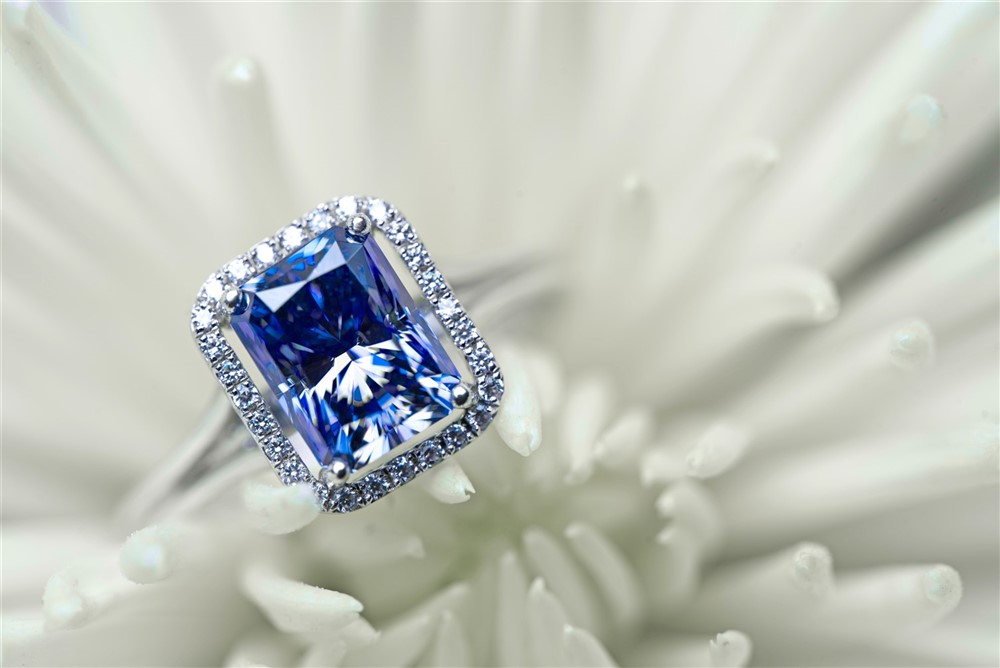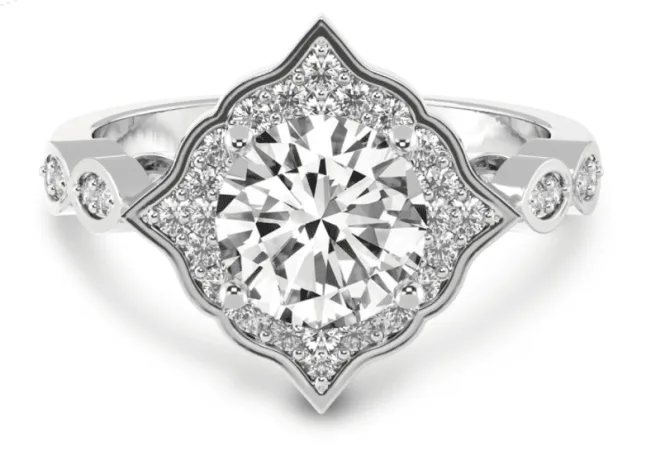The Essential Guide to Vintage Engagement Rings | Rare Carat
What’s old is new again my friends! Vintage engagement rings are super trendy right now, and for good reason. They remind us of a previous time, which has a certain sentimental value I think, but they also have such strong design details that it allows them to be little pieces of wearable finger art. And if you aren’t very familiar with vintage engagement rings - you’re about to be! I will explain what makes something truly vintage, we will discuss the most popular vintage eras we love (broken down by aesthetics, gems of choice, and basic ideas on how to recreate each period's design), and to finish I will touch on the three most common diamond cuts that you will come across during your vintage exploration adventure. It really is the character and charm of a vintage style that tops any modern ring, which is exactly why this trend is rapidly growing in popularity.
What is Vintage
So, what does vintage actually mean? Usually, the assumption is it just means something old…which is totally true. An item has to be at least 20 years old before being considered vintage (which qualifies the 90s as vintage now…like whaaaat??). This is different than being an antique though! A certified antique is much older, only being considered a true antique at a minimum of 100 years old (kind of makes me wonder if people can be considered antiques?). This technically means that vintage is anything between 20-99 years old, and an antique is anything 100+.
With that said, you can buy a true vintage ring with the authentic history (and previous wear) connected to it, or you can design a new ring to look like a vintage engagement ring - which technically isn’t vintage, just vintage style (if that matters to you). Either way, you will be getting the vintage aesthetic, which is where the unique beauty of the artistry is anyways.
Most Popular Vintage Eras
Before the 20th century, jewelry had been a luxury for mostly royals or very wealthy people. As the middle class started to develop, the jewelry industry began to evolve. This is where our distinctive vintage eras come into play. The most popular periods were Art Nouveau, Edwardian, Art Deco, and Retro, with each of these having their own inspired, original style. Check out the diamonds through the era's on our blog.
Art Nouveau
Aesthetics
The Art Nouveau period, which literally translates from French into New Art, was from 1890-1914. The inspiration for this era was the natural world…mostly thought to be used as a protest to the industrial world quickly growing around them. Free-flowing, curvy lines, a variety of different portrayals of nature and nature motifs, plus a few mythical creatures thrown in, were the general aesthetic of this time. This could look like a flowering broach with soft, curved lines (nature motif) or a whimsical mermaid pendant that is enameled in gold (mythical creature)(... or are they...?!).
Gemstones
The common gemstones found in Art Nouveau jewelry are moonstones, amethyst or rose quartz, opals, pearls, tourmalines, chalcedony, chrysoprase, and aquamarine. Okay but really what you need to know for engagement ring purposes specifically is that none of these stones would necessarily be the best option as the stone of choice because they are too soft. Some of these gems are softer than others, but they all scratch fairly easily. When choosing a stone for a ring that is going to be worn every day (for decades), hardness is mostly the priority… but so is personal preference! If one of these is your favorite stone, or you just want a truly authentic Art Nouveau ring, definitely go for it! I guarantee you will still love the ring forever, even with a few scratches.
Design Examples
An example of what an engagement ring from this period could look like might be an aquamarine center stone surrounded by gold or silver leafy vines that gently cascade around the entire finger, enclosing it…very whimsical. Or perhaps a large moonstone being held in place perfectly by two fairies hoisting it up. I think the best part about this era is the limitless creativity that is possible.
Edwardian
Aesthetics
The Edwardian period actually overlaps with Art Nouveau, and is named after England’s King Edward VII (also, interestingly, the last period influenced by a British monarch). This era was from 1900-1915, in which the upper classes of the US and Europe showcased fine metals and fine gemstones in their jewelry. Some considered this time to be the height of elegance and sophistication, and the jewelry aesthetic was designed to reflect that. Delicately lacey, or ethereal and light, glittery garlands, and ornate features are what defined this time.
Gemstones
Along with the explosion of platinum as the metal of choice at this point, the gems preferred were stones like diamonds, pearls, emeralds, rubies, sapphires, opals, or even cat’s-eye chrysoberyl. Of these, diamond, ruby, and sapphire would all be great options as a practical stone for an engagement ring since they are very hard, scratch-resistant gemstones. Side note - I really love sapphire as a unique choice because it comes in almost any color, which is extremely convenient for custom designs.

Design Examples
An Edwardian era ring might look something like a single diamond surrounded by a dainty, lacy, platinum halo, with little baby pearls nestled throughout…or maybe a fine, intricate, platinum floral pattern ring that is spotted perfectly with small yellow sapphires. Think delicate, opulent, elegance!
Art Deco
Aesthetics
The Art Deco period came about post World War I, completely dominating the 1920s and 1930s. This style feels like a revolt of the previous eras where nature and soft sophistication reigned supreme. Now is when we start getting into the use of bright, contrasting primary colors, often in geometric patterns, that are laid out in abstract designs. We also see tons of sleek looks emphasizing the vertical line. The softness and finesse of previous eras is definitely gone by this point in design time.
Gemstones
Since primary colors ruled the Art Deco era, the gemstones heavily used display exactly that. Rubies, sapphires, emeralds, diamonds, topaz, turquoise, black onyx, and lapis lazuli are the main stones preferred. Some of these gemstones could also be carved into shapes or be cabochon cut (cut with a flat bottom and a smooth, rounded, domed top). Worth repeating- diamond, sapphire, and ruby are the hardest gems of this group, so they would be the most practical choice for an engagement ring.
Design Examples
Fun examples of art deco style could be something like a round, white diamond, outlined by a square-shaped box of vibrant blue sapphires, held together with a platinum band. We could also see a bright green emerald with several smaller rectangular-shaped diamonds on each side, set in a gold ring. Lots of sharp shapes, lots of vivid, contrasting colors!
Retro
Aesthetics
Whenever World War II ensued, it ended the Art Deco period, thrusting us into the Reto era. Both platinum and gemstones were in short supply because of the war, which really had influence on the Retro design. The sharp designs and bright colors of Art Deco started to soften, the use of big gemstones decreased, and gold became heavily relied on instead of platinum. Mechanical type objects, like padlocks or bike chains, floral motifs, and sculpted curves inspired a lot of the most recognizable Retro era pieces.
Gemstones
Because gemstones were less available, they were more scarcely used within the jewelry designs (makes sense to me). Smaller diamonds, light-colored sapphires, and often synthetic rubies were the few gems regularly used in Retro designs. The smaller stones, if there are any, will often be scattered around the piece instead of having a large, focal gemstone.
Design Examples
So, a Retro engagement design idea could feature a double haloed ring, with small pastel colored sapphires spread throughout the halos, and set into a yellow gold band. A line ring with small diamonds and synthetic rubies going horizontally across the finger, also set in a yellow gold band, would be another good example. This design period feels like highlights from the previous eras mixed together, but in a more conservative and simplistic form.
Vintage Diamond Cuts
There are three distinctive diamond cuts that will easily elevate your ring to a vintage design - rose cut, old-mine cut, and old European cut. These aren’t necessarily the only way diamonds were cut during this time, but they were the most common. In fact, the old-mine and old European cuts were the inspiration for our mega popular modern round brilliant cut.

The rose cut is one of the oldest advanced cuts we have. This cut has more of a domed top (crown) and a flat bottom (pavilion), with the domed crown covered in triangle shaped facets. The reason it was named rose cut was that it mimicked the rose’s petals as they open up. I kind of imagine this cut being similar to a half disco ball in that the whole top half is faceted. The major downside to the rose cut is that because it is shallow, without the deep pavilion, it can’t reflect the white light back towards you like a modern diamond. This means the diamond essentially becomes see-through instead of looking bright and white and sparkly. Mostly I love the rose cut for what it is, not what it is not.
The Old-Mine cut is named after… wait for it… the miners from the old mines, where the diamonds were being mined from. Old-mine diamonds are recognizable by their cushion shaped outline (think rounded square), with a high crown and deep pavilion. They have this distinctively large culet, which is a flat cut bottom instead of a sharp point on a diamond. This is a significant characteristic because you can see the large culet through the top of the diamond when looking down at it (literally looks like a circle through the center of the stone). Very distinctive!
The Old European cut is similar but has more of a circular outline versus the cushion shaped old-mine cut. The round shape was very new and dramatic at the time, which is the biggest difference between the old European and old-mine cuts. There is still a larger culet that is noticeable in the old European, but just not quite as exaggerated.
After the old European cut’s success, someone very smart (Marcel Tolkowsky to be exact) decided to figure out actual angles and measurements, and other scientific dimensions for more precise diamond cutting standards. This cutting guide was an attempt to try to methodically optimize the potential for fire, sparkle, and brilliance of all diamonds. This work is the direct link to where our modern round brilliant diamonds come from.
Vintage engagement rings are fun! They allow us to have more, dare I say - creative options to design a ring around. Style is always evolving so if you aren’t a big modern design person then there is an entire world of vintage style concepts that could be perfect for you. I really enjoy the artistry of the past being reflected in a ring that represents a promise for today, and for the future. It seems like a very poetic and full-circle decision for an engagement ring.

